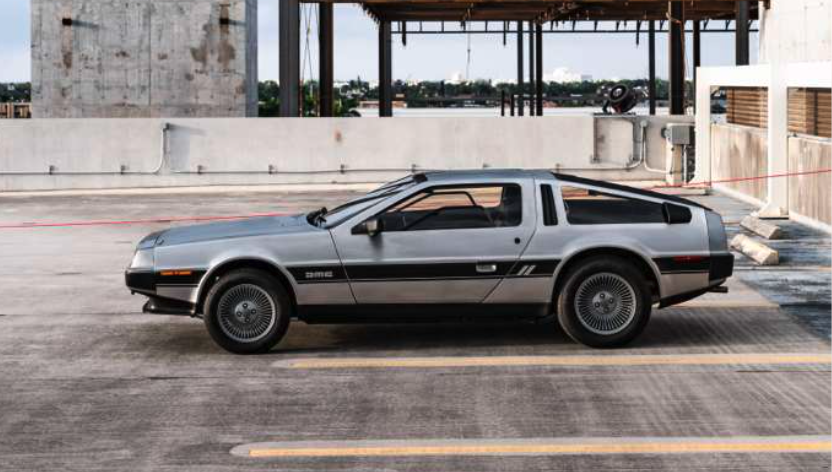
OWNERS NAME: Jahanzaib Majid
YEAR: 1981
MAKE: DeLorean
MODEL: DMC – 12
SUB MODEL:
BRIEF MANUFACTURER DETAILS AND SIGNIFICANT HISTORY OF CAR:
Welcome to a rare glimpse of automotive history—a 1981 DeLorean DMC-12 preserved in remarkable, near-factory condition with just 4,000 miles on the odometer. This vehicle is not just a car; it’s the realization of a maverick’s dream, a pop culture legend, and a time capsule from a unique moment in manufacturing history.
A Visionary Design
Born from the mind of auto industry rebel John Z. DeLorean, the DMC-12 was conceived as an “ethical sports car” built to be safe, fuel-efficient, and durable. To bring his vision to life, he commissioned legendary Italian designer Giorgetto Giugiaro, who was renowned for his “folded paper” or “origami” design language that favored sharp, geometric lines. The result was a stunning and futuristic wedge-shaped silhouette.
The car’s most revolutionary feature is its body, paneled in brushed SAE 304 austenitic stainless steel, the same type used in the catering industry. This gave the car its signature unpainted sheen and was intended to make it impervious to corrosion. The steel panels are fixed to a glass-reinforced plastic underbody, a construction that made traditional dent repair impossible; DeLorean intended for damaged panels to be replaced entirely. Completing the otherworldly look are the iconic gull-wing doors, inspired by the 1954 Mercedes-Benz 300SL. To function, they required a sophisticated system of cryogenically treated torsion bars developed by Grumman Aerospace.
A Global Collaboration and Technical Details
The DMC-12 was a truly international effort. When initial plans for a new chassis technology proved unworkable, DeLorean turned to Colin Chapman, the legendary founder of Lotus Cars. Chapman’s team engineered a robust steel backbone chassis, similar to the one used in the Lotus Esprit, giving the car a solid foundation.
Its heart, however, came from a Franco-Swedish partnership: a rear-mounted 2.85-liter V6 engine developed jointly by Peugeot, Renault, and Volvo (PRV). While reliable, the engine produced a modest 130 horsepower, resulting in performance (0-60 mph in about 9.5 seconds) that was considered underwhelming for a car with such exotic looks. The car was assembled in a state-of-the-art factory in Dunmurry, Northern Ireland, a project heavily funded by the British government to bring jobs and hope to a region beset by conflict.
A Time Capsule Example
This specific vehicle is a highly desirable early production model from 1981. Its status is marked by the distinctive grooved hood with an integrated gas flap—a feature that was phased out in August 1981 as a rolling production change. With its exceptionally low mileage, it represents a rare opportunity to see a DeLorean as it was when it first left the factory, equipped with its original black leather interior and standard luxury features for the era, including air conditioning, power windows, a tilt and telescopic steering column, and an AM/FM cassette stereo.
From Showroom to Stardom
Though the DeLorean Motor Company’s production run was short (1981–1982), the car’s story was just beginning. In 1985, the DMC-12 was cast as the time machine in the blockbuster film Back to the Future. Director Robert Zemeckis and writer Bob Gale chose the car specifically because its stainless steel body and gull-wing doors made it look like a UFO, a believable sight to shock a 1950s family.
The film transformed the car into a cultural icon, outfitting it with a “Flux Capacitor” and a rear-mounted nuclear reactor (famously made from a Dodge Polara hubcap). The movie cleverly played on the car’s real-world reputation for unreliability by having it stall at critical moments, adding to the on-screen drama. The DeLorean’s cinematic rebirth secured its immortality, forever cementing its place not just in automotive history, but in the heart of popular culture
BRIEF STORY OF THIS PARTICULAR VEHICLE:
Restored and Reimagined: A Modern Tribute
While this DeLorean has been meticulously restored to preserve its original 1981 factory appearance, it has also been thoughtfully enhanced to celebrate its legendary cinematic role. This car bridges the gap between automotive history and movie magic with several custom modifications designed to create an interactive and unforgettable experience.
The iconic gull-wing doors, a hallmark of the DeLorean’s futuristic design, have been upgraded with a “Wings-A-Loft” system. This modern convenience allows the doors to open automatically via remote control, adding a touch of contemporary technology to their timeless appeal.
Inside, the world of Back to the Future comes to life. A fully operational Flux Capacitor replica has been installed between the seats. When activated, it lights up and performs the same mesmerizing animations seen on screen, accompanied by music from the film’s classic soundtrack.
Complementing this is a functional Time Circuit display on the dashboard. This interactive feature allows you to program specific dates and times, triggering its own set of animations and bringing the experience of time travel one step closer to reality.
To complete the time machine transformation, a replica of the movie’s digital speedometer has been installed. In the film, a custom speedometer was needed because federal law at the time limited speedometers to 85 mph—just shy of the 88 mph required for time travel. This fully functional, movie-accurate display works in tandem with the car’s original analog speedometer to show the vehicle’s actual speed, ready for its next journe
